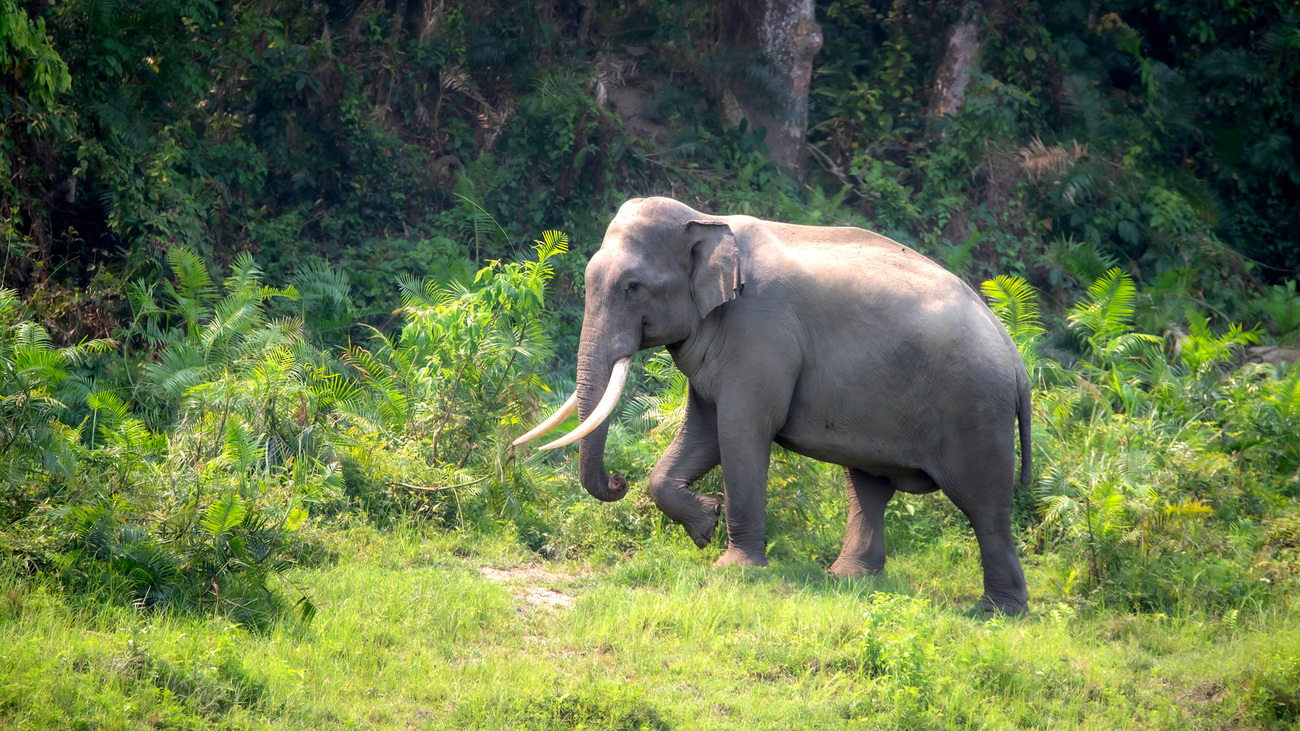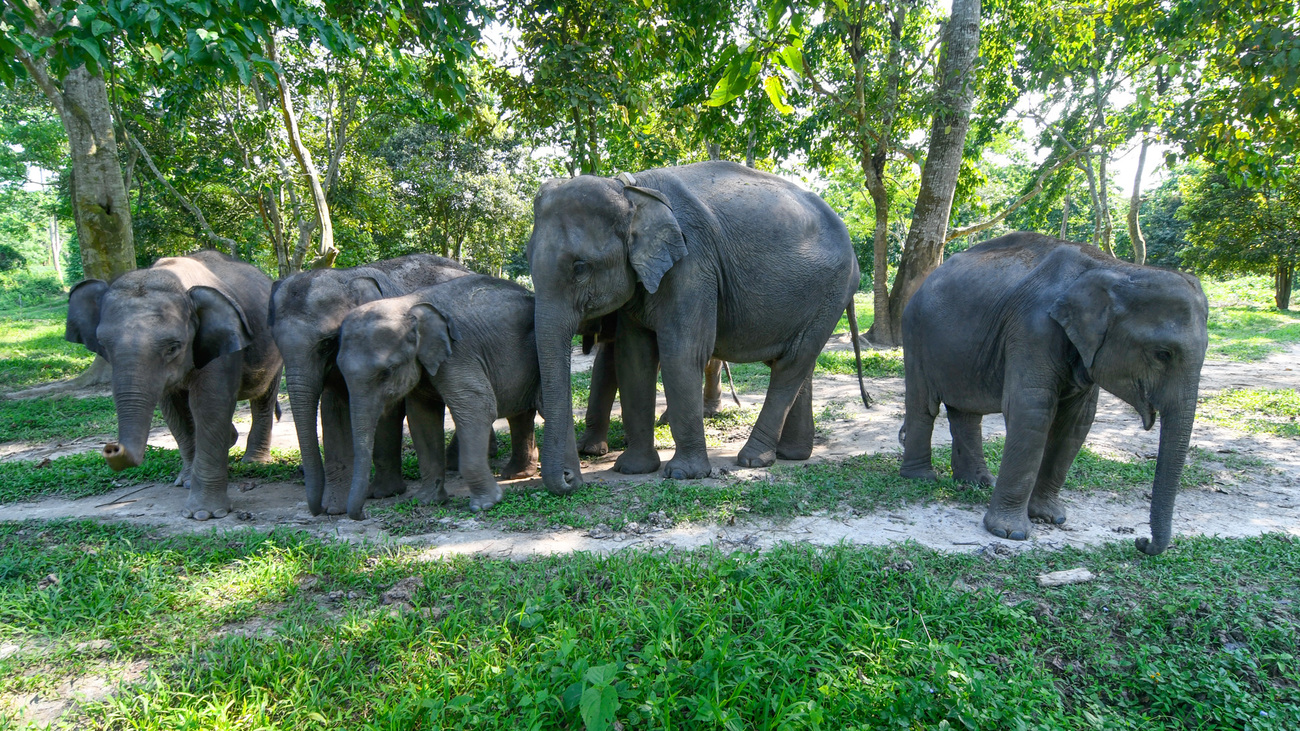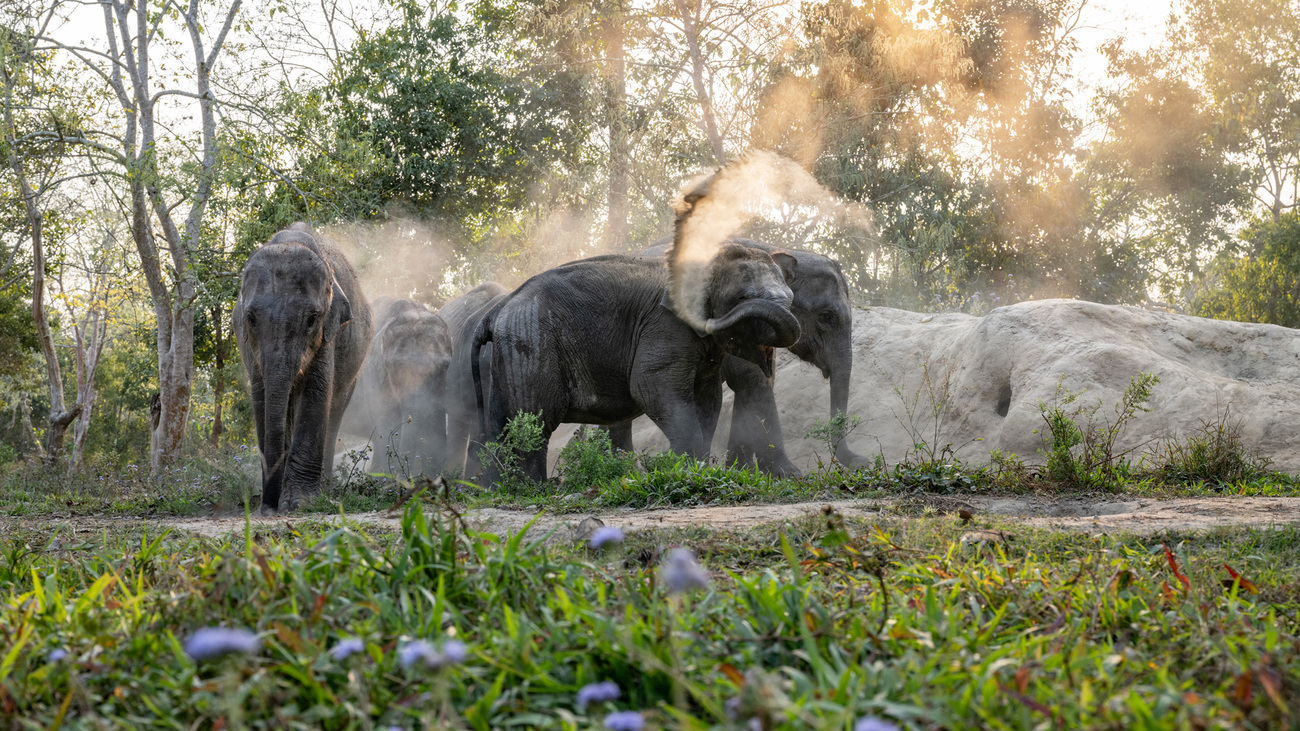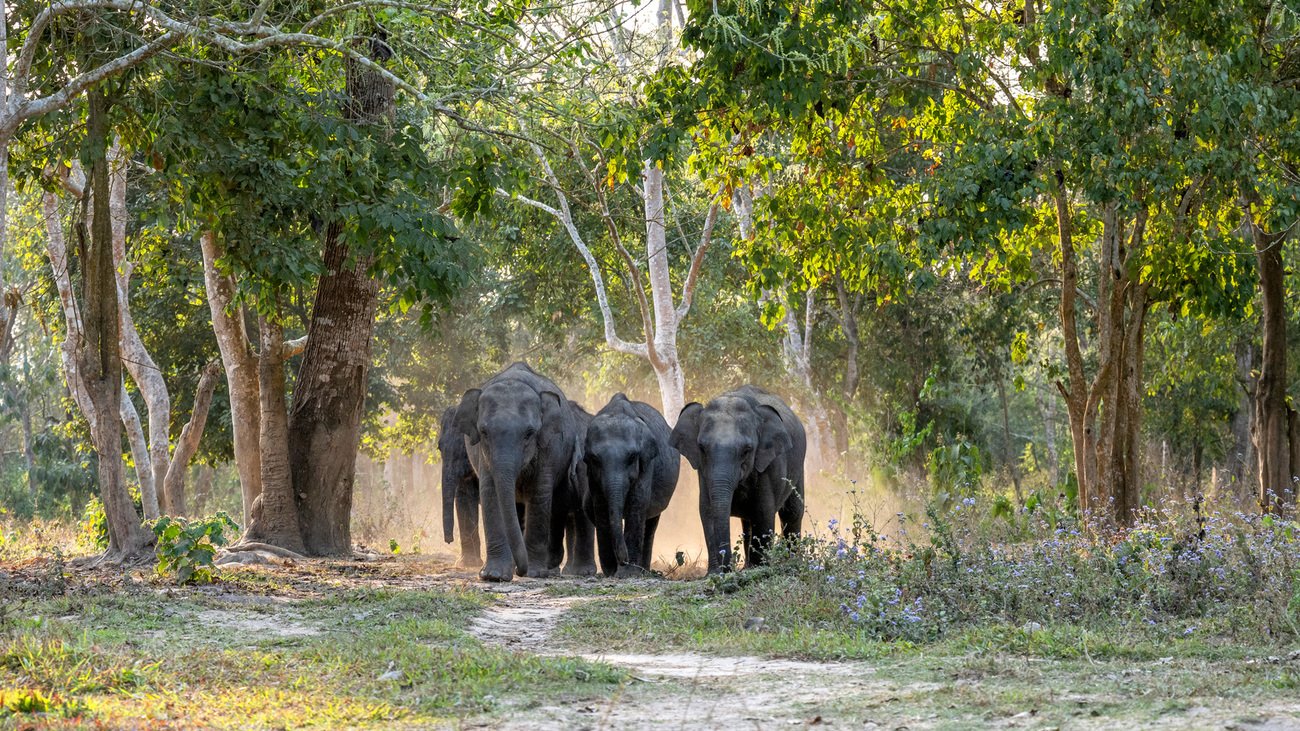Indian elephants
What are Indian elephants?
Indian elephants are a subspecies of Asian elephants native to the Indian subcontinent that represent around 60% of all Asian elephants. They are highly intelligent animals with complex social structures that display emotional intelligence. The females live in tight-knit family groups led by elderly matriarchs, while males typically live alone.
Indian elephants are similar to their Asian elephant cousins, the Sumatran and Sri Lankan elephants, but are distinguishable from their African cousins by their smaller, more rounded ears and their smaller bodies. Mature Indian elephants are two to three meters (6.6 to 9.8 feet) tall at the shoulders and weigh anywhere from 2,000 to 5,000 kilograms (2.25 to 5.5 tonnes), making them up to one meter smaller and 3,000 kilograms lighter than their African counterparts. Indian elephants also have thinner skin and less hair.
Indian elephants are herbivores and spend up to 19 hours a day eating as much as 136 kilograms (300 pounds) of fruit, grasses, roots, and bark. They are migratory animals with large home ranges, meaning they wander across their forest habitat searching for food, water, and mates.
These habits make them a keystone species—one on which other animals rely for their survival—as they disperse seeds through their faeces and promote vegetation growth by creating clearings and trails that allow more light to reach the forest floor. In short, they play a vital role in the ecosystems in which they live, helping to maintain the biodiversity and ecological health of these regions. However, due to threats like habitat loss and poaching, Indian elephant populations are declining rapidly.
What is an Indian elephant's scientific name?
The scientific name for the Indian elephant is Elephas maximus indicus, roughly translating to ‘greatest elephant from India’. It is one of three subspecies of Asian elephants, the two other being the Sumatran and Sri Lankan elephants, known scientifically as Elephas maximus sumatrensis and Elephas maximus maximus.
Are Indian elephants endangered?
The IUCN Red List has listed Indian elephants as endangered since 1986 because their population and the quality of their habitat are in decline. The number of Asian elephants overall has decreased by 50% over the last three generations, while the population size of Indian elephants has decreased by 11% in just 30 years. These large mammals face human-caused threats, including habitat loss and fragmentation, as well as poaching and human-animal conflict.
Where do Indian elephants live?
Indian elephants are the only Asian elephants that live in mainland Asia. Here, they inhabit a range of different habitats, including dry-thorn forests, moist and dry deciduous forests, tropical evergreen and semi-evergreen forests, as well as cultivated and secondary forests.
They migrate throughout the year in search of vegetation and water, though they do have home ranges too. The size of a range varies based on the number of elephants in the area, as well as the quality and availability of food.
Threats
Indian elephants live in some of the most densely populated areas in the world. As human populations continue to grow, so do human activities that encroach on the elephant’s natural habitat. These man-made threats have created numerous challenges for elephants, including habitat loss, poaching, and human-elephant conflict.

Habitat loss and fragmentation
Indian elephants follow specific migratory routes that provide them with the space and resources they need to roam and feed. However, human populations are expanding into these natural areas by building housing, planting crops, and constructing roads and railways. Such infrastructure has reduced elephants’ natural habitat to just 3.5% of its former size. As a result, their populations are becoming increasingly isolated and fragmented, making it more difficult for them to find water, food, and mates.
Human-wildlife conflict
As human settlements expand, elephant habitat shrinks, and the likelihood of elephants entering residential and agricultural areas increases. In their search for food and water, elephants are now more than ever prone to raiding crops and accidentally damaging property. They are also more likely to come into contact with humans, sometimes hurting or killing them out of fear. These conflicts have increased tensions between humans and elephants and often lead to retaliatory killings.
Poaching
Though Indian elephants (and Asian elephants more broadly) are less of a target than their African cousins, they are still targeted by poachers for their ivory tusks, skin, and other body parts, which are highly valuable on the black market. They are also hunted for sport in some areas.
To help save these endangered animals, conservation organizations support anti-poaching efforts by educating local communities about the important role elephants play within their ecosystems and by strengthening law enforcement. Wildlife corridors are also being built to connect isolated elephant populations and protect their migratory routes, while protected areas are being created across India.
FAQs
Do Indian elephants have tusks?
While bot male and female African elephants have tusks, only male Indian elephants can grow tusks. However, some female Indian elephants have ‘tushes’ which lookh like small tusks and protrude around two to five centimeters (one to two inches) from their lip line, though these aren’t made of ivory.

Are African elephants bigger than Indian elephants?
African elephants are larger than Indian elephants. African elephants weigh over 8,000 kilograms (nine tonnes), while Indian elephants only weigh up to 5,000 kilograms (six tonnes).
African elephants are also larger and taller, standing up to four meters (13 feet) tall at the shoulders, compared to Indian elephants who typically reach heights of three meters (10 feet) at most.
Do Indian or African elephants have bigger ears?
Indian elephants have much smaller, more rounded ears than African elephants.
Can Indian elephants breed with African elephants?
Because they diverged as separate species millions of years ago, Indian and African elephants cannot breed with one another and produce healthy offspring. The only known Indian-African elephant hybrid was Motty, born in Chester Zoo, England, in 1978. He sadly died just a few days after being born.
How big is an Indian elephant?
Adult Indian elephants stand around two to three meters (6.6 to 9.8 feet) tall at the shoulder and weigh around 2,000 to 5,000 kilograms (2.25 to 5.5 tonnes). Calves are usually around 100 centimeters tall (3.3 feet) and 90 kilograms (200 pounds) when they’re first born.
How fast can an Indian elephant run?
Indian elephants can run at speeds of up to 24 kilometers per hour (15 miles per hour). Interestingly, though, elephants don’t look like they’re running even when they achieve such speeds because their four feet never leave the ground at the same time. Instead, their footfall pattern while running is the same as when they walk.
How long does an Indian elephant live?
Indian elephants live for up to 60 years in the wild, though the oldest known Indian elephant in captivity was Dakshayani, who died at the age of 88.
What do Indian elephants eat?
Indian elephants spend up to 19 hours a day eating up to 136 kilograms (300 pounds) of food. They are herbivores and eat large quantities of fruit, grasses, roots, and bark.
Our work
IFAW supports a range of conservation efforts to help protect Indian elephants.
Ensuring habitat connectivity
For over a decade, IFAW has been working with the Wildlife Trust of India (WTI) to help protect elephant corridors and allow these animals to move safely between their traditional habitats. There are 101 corridors that need protecting, and while our work has secured and donated the land for some of these corridors, more work is needed to secure the others.
As part of these efforts, we also support a range of local projects that aim to mobilize and inspire local communities to protect and preserve elephant corridors. These include parades, flag ceremonies, and festivals across India.

Supporting peaceful human-elephant coexistence
In Barpathar village in Assam’s Manas National Park—a landscape that humans and elephants share—families rely on wood as their primary source of energy for heating and cooking. When venturing into the forest to get this wood, though, they often encounter Indian elephants—which can have deadly consequences.
IFAW and WTI have been working in villages like Barpathar to help families become less dependent on the forest. The Assam Haathi cookstove project, for example, provides over 2,500 families with better stoves that require less wood. This helps protect the forest, reduce dangerous trips by 30%, and avoid elephant-human interactions.
Rescuing injured animals
As humans build more roads and railways across elephants’ migratory routes, collisions between vehicles and animals are increasingly frequent. This is particularly common on Highway 715, which runs by Kaziranga National Park in India.
IFAW and WTI have partnered with the Assam Forest Department to create a rehabilitation facility that helps elephants that have been hit by vehicles on this highway. Here, we provide emergency care for injured animals and recover orphaned elephants before releasing them back into the wild. Since its inception in 2000, 5,500 animals have been rescued and almost 3,500 healthy animals have been released back into the wild.
Protecting and restoring habitat
Three decades ago, local conflict in Assam, India, had devastating consequences for Manas National Park, where poaching, deforestation, and fragmentation led to a considerable decline in Indian elephant populations.
Working with WTI and the Assam Forest Department, IFAW helped to double the size of protected forest in the Greater Manas landscape, allowing Indian elephants to thrive once again. We also pioneered change within local communities, encouraging them to preserve this national park for years to come.
How can you help?
Indian elephants face an uncertain future, with habitat loss, poaching, and human-wildlife conflict all threatening their survival. However, targeted conservation efforts can help protect these animals and their habitats.
